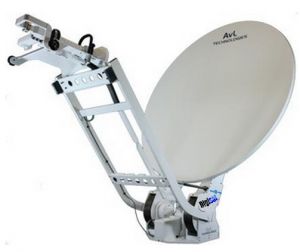AVL Technologies 2012K Vehicular Mount Global SNG VSAT Antenna System
Intelsat, Panamsat, Eutelsat and Asiasat approved, Ideal for Ku-Band uplink trucks, VSAT trailers and remote internet access applications
2012K Vehicle Mount MVSAT Uplink Antenna
AVL 2012K 2.0M Vehicular Mounted SNG VSAT Antenna is built using a state of the art and rugged one piece light weight carbon fiber reflector.
The 2012K SNG VSAT Antenna is also available with custom options such as a standard or wideband feed.

Key Features:
![]() Reflector- 2.0 meter AvL Carbon Fiber
Reflector- 2.0 meter AvL Carbon Fiber
![]() Feed- Standard or Wideband
Feed- Standard or Wideband
![]() Optics- Offset, Prime Focus, .6 f/d
Optics- Offset, Prime Focus, .6 f/d
![]() Az/El Drive System- Patented Roto-Lok Positioner
Az/El Drive System- Patented Roto-Lok Positioner
![]() Mount Geometry- Elevation over Azimuth
Mount Geometry- Elevation over Azimuth
![]() Polarization Adjustment- Rotation of Feed
Polarization Adjustment- Rotation of Feed

2012K AvL Antenna Specifications |
|
|
Reflector |
2.0 meter AvL Carbon-Fiber |
|
Feed |
Mode-Matched Horn |
|
Optics |
Offset, Prime Focus, .8 f/d |
|
Az/El Drive System |
Patented Roto-Lok® Positioner |
|
Mount Geometry |
Elevation over Azimuth |
|
Polarization Adjustment |
Rotation of Feed |
Electrical RF |
|
|
Frequency |
|
|
Gain (Midband) |
|
|
VSWR |
|
|
Beamwidth (degrees) |
|
|
First Sidelobe Level (Typical) |
|
|
Radiation Pattern Compliance |
>3 dB better than FCC §25.209, ITU-R S.528.5 |
|
Antenna Noise Temperature |
47° K at 30° Elevation |
|
Polarization |
Linear Orthogonal Standard, Optional Co-pol |
|
Power Handling Capacity |
0.5KW per port |
|
Cross-Pol Isolation |
|
|
Feed Port Isolation - TX to RX |
75 dB |
|
Satellite System Compliance |
FCC, PanAmSat, Intelsat, Eutelsat, AsiaSat |
Control |
|
|
Standard |
Three-axis Jog Control & Display with Auto-stow |
Optional Upgrades |
|
|
Semi-automatic Operation |
Drive to calculated position based on operator entered |
|
Automatic Operation |
Drive to calculated position based on auto GPS and Flux- Gate Compass data and satellite peaking with LNB signal |
|
Size |
Two Rack Units for Semi-automatic & Automatic Controllers Single Rack Unit for Auto-acquisition |
|
Input Power |
110/240 VAC, 1 ph, 50/60 Hz,15 amps peak |
Mechanical |
|
|
Az/El Drive System |
Patented Roto-Lok® Cable Drive System |
|
Polarization Drive System |
Non back-driving Worm Gear |
|
Travel |
|
|
Speed |
|
|
Motors |
24V DC Variable Speed, Constant Torque |
|
RF Interface |
|
|
Electrical Interface |
25 ft. (8 m) Cable with Connectors for Controller |
|
Manual Drive |
Handcrank on Az and El Axii, Leads from 12VDC Pol Motor |
|
Weight |
300 lbs. (136 kgs) |
|
Stowed Dimensions |
103½ L x 80 W x 20 H inches (263 L x 203 W x 51 H cm) |
Environmental |
|
|
Wind |
|
|
Pointing Loss in Wind |
|
|
Temperature |
|
Remote Satellite Communications- Internet Access, Video Broadcast, Live Event Streaming, Multi-Media Delivery, GSM Backhaul




